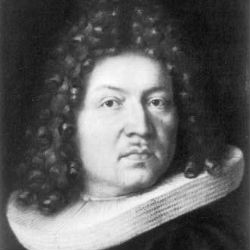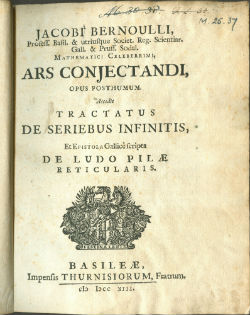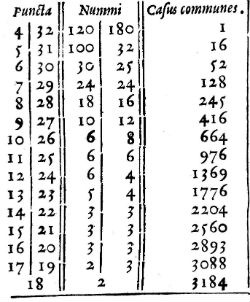
Ars Conjectandi is not a book that non-statisticians will have heard of, nor one that many statisticians will have heard of either. The title means ‘The Art of Conjecturing’ – which in turn means roughly ‘What You Can Work Out From the Evidence.’ But it is worth statisticians celebrating it, because it is the book that gave an adequate mathematical foundation to their discipline, and it was published 300 years ago this year.
More people will have heard of its author. Jacob Bernouilli was one of a huge mathematical family of Bernoullis. In physics, aircraft engineers base everything they do on Bernoulli’s principle. It explains how aircraft wings give lift, is the basis of fluid dynamics, and was discovered by Jacob’s nephew Daniel Bernoulli.
Johann Bernoulli made important advances in mathematical calculus. He was Jacob’s younger brother – the two fell out bitterly. Johann fell out with his fluid-dynamics son Daniel, too, and even falsified the date on a book of his own to try to show that he had discovered the principle first.
But our statistical Bernoulli is Jacob. In the higher reaches of pure mathematics he is loved for Bernoulli numbers, which are fiendishly complicated things which I do not pretend to understand but which apparently underpin number theory. In statistics, his contribution was two-fold: Bernoulli trials are, essentially, coinflips repeated lots of times. Toss a fair coin ten times, and you might well get 6 heads and four tails rather than an exact 5/5 split. Toss 100 times and you are quite unlikely to get 60 heads and 40 tails. The more times you toss the coin, the closer you will get to a 50-50 result.
His second statistical result was more fundamental, though related. Suppose you have an urn with 3000 white pebbles and 2000 black pebbles. You take out a pebble, look at its colour, and return it. Then do it again; and again; and again. After ten times you might guess that there were 2/3 as many black pebbles as white; after 1000 times you might feel a bit more sure of it. Can you do this so often that you become absolutely sure – morally certain, as Bernoulli put it – that the pebbles in the vase were actually in the ratio of 3 to 2? Or would that conclusion forever remain just a conjecture?
 If it is just a conjecture, then all of statistics is built on sand. Happily, Bernoulli showed it was more than a conjecture; he spent years thinking about it, managed to prove it was true – and when he had done so he called it his Golden Theorem as it was the crown of his life’s work. The more time you repeat a series of experiments like this, the closer your result will get to the true one. Statisticians are rather pleased that he proved it. If it had stayed a conjecture, there would have been no need to believe anything (statistical) that a statistician told you.
If it is just a conjecture, then all of statistics is built on sand. Happily, Bernoulli showed it was more than a conjecture; he spent years thinking about it, managed to prove it was true – and when he had done so he called it his Golden Theorem as it was the crown of his life’s work. The more time you repeat a series of experiments like this, the closer your result will get to the true one. Statisticians are rather pleased that he proved it. If it had stayed a conjecture, there would have been no need to believe anything (statistical) that a statistician told you.
We shall have a major scholarly piece on Ars Conjectandi in our June issue, out on paper and on this site shortly. A challenge: can you correct something that Jacob Bernoulli got wrong? It stayed wrong for nearly 300 years until our author, Professor Antony Edwards, spotted it and corrected it.
Here is the problem: It is a simple exercise in schoolboy probability. It is Problem XVII in Part III of Bernoulli’s book. For those who would like to try their hand, the problem is as follows.
 In a version of roulette, the wheel is surrounded by 32 equal pockets marked 1 to 8 four times over. Four balls are released and are flung at random into the pockets, no more than one in each. The sum of the numbers of the four occupied pockets determines the prize (in francs, say) according to a table which Bernoulli gives – it is on the right. The cost of a throw is 4 francs. What is the player’s expectation? That is, how much, in the long run, can he expect to walk away with per game?
In a version of roulette, the wheel is surrounded by 32 equal pockets marked 1 to 8 four times over. Four balls are released and are flung at random into the pockets, no more than one in each. The sum of the numbers of the four occupied pockets determines the prize (in francs, say) according to a table which Bernoulli gives – it is on the right. The cost of a throw is 4 francs. What is the player’s expectation? That is, how much, in the long run, can he expect to walk away with per game?
The left-hand columns in the table are the total four-ball score; centre columns are the paybacks for a four-franc stake; the right-hand columns are the number of combinations that could give rise to the score.
The answer Bernoulli gives in the book is 4 + 349/3596, which is 4.0971. Professor Edwards comes up with a different answer, which we shall give in his article in the magazine section of this site when the issue goes live in about a week. Which do you agree with?
And happy calculating…




